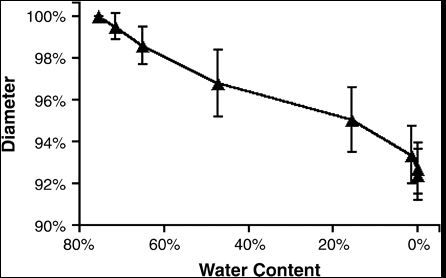Anteneh Gashaw443
Posted in Advancing Innovation for Invasive Species Management
Saving the 'Ohi'a: Hawai'i's Sacred Tree
and visible to The Public
Diameter difference to detect the ROD fungus to save the Ohi'a tree

According to many research results, most of the dead trees showed a decrease in diameter growth when tree is dying. This could indicate that the stem contracted due to loss of moisture because the tree could not absorb the necessary water through the roots.
The stem cross-sections of live trees have 75.6 per cent water content by dry weight, and when the moisture declined due to their being dried, their diameter also decreased. Expressing this decline as a percentage of the original cross-section diameter, it decreased 7.6 percent compared with the original dimensions. This diameter decrease did not have a linear relationship with the loss in the humidity content, where it was greater at water contents less than 20 percent. The bark and the wood did not decrease in the same proportion. Wood occupied 90.5 percent of the cross-section diameter when its water content was at its maximum, but changed to 93.5 percent with the minimum water content. For these, the bark had a greater reduction (9.5–6.5 percent of the cross-sections diameter) when water content was lowered.
That means a tree which is starting to be dry will show a decrease in diameter in its steam. It is known that the ROD fungus attacks the Ohi'a tree by chocking the water transport until it dies out of the water. That means it is obvious that infected Ohi'a tree have a decreasing diameter of their steam
We can use this sign to get the symptom when they are infected or dying. The best method is tieing a coloured string in every tree and if the tree is infected the string will start to fall because of a decrease in the diameter.
I am amazed to say that I have thought many possible solutions, many experiments relating to trees water loss and I think this is the easiest solution. The first step is seeing if the change in diameter of the infected Ohi'a tree is somewhat noticeable and tie a coloured string to test my theory.
The stem cross-sections of live trees have 75.6 per cent water content by dry weight, and when the moisture declined due to their being dried, their diameter also decreased. Expressing this decline as a percentage of the original cross-section diameter, it decreased 7.6 percent compared with the original dimensions. This diameter decrease did not have a linear relationship with the loss in the humidity content, where it was greater at water contents less than 20 percent. The bark and the wood did not decrease in the same proportion. Wood occupied 90.5 percent of the cross-section diameter when its water content was at its maximum, but changed to 93.5 percent with the minimum water content. For these, the bark had a greater reduction (9.5–6.5 percent of the cross-sections diameter) when water content was lowered.
That means a tree which is starting to be dry will show a decrease in diameter in its steam. It is known that the ROD fungus attacks the Ohi'a tree by chocking the water transport until it dies out of the water. That means it is obvious that infected Ohi'a tree have a decreasing diameter of their steam
We can use this sign to get the symptom when they are infected or dying. The best method is tieing a coloured string in every tree and if the tree is infected the string will start to fall because of a decrease in the diameter.
I am amazed to say that I have thought many possible solutions, many experiments relating to trees water loss and I think this is the easiest solution. The first step is seeing if the change in diameter of the infected Ohi'a tree is somewhat noticeable and tie a coloured string to test my theory.
Hey @Anteneh Gashaw - could you post the link to the research you are citing here? This looks interesting, but I don't quite understand some of it, such as how it says "the bark and the wood did not decrease in the same proportion." Would be interested to read this context.
by Tom Quigley
I thought I included the link for my reference. @Tom Quigley thanks for requesting. You can find it via https://academic.oup.com/forestry/article/80/1/83/634218
Let me know your thought after you do your research.
Let me know your thought after you do your research.